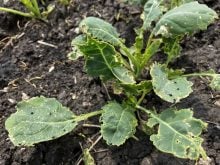Scratching out a new surface drain is one thing. Moving thousands of cubic yards of soil away from a ditch so it doesn’t form a dike is quite another.
The deeper and longer the drain, the more spoils, or dirt, you need to move. If you don’t move the spoil soil far enough, you can inadvertently build a shallow dike that blocks water from flowing into your new masterpiece.
Farmers using a scraper with a good drainage prescription map can drag soil into potholes located at higher points in the field.
Read Also

Growing garlic by the thousands in Manitoba
Grower holds a planting party day every fall as a crowd gathers to help put 28,000 plants, and sometimes more, into theground
Newer design concepts such as Jeff Penner’s V-Wing and Kevin Hruska’s Pulldozer Transformer are finding favour with farmers.
However, a lot of farmers prefer the traditional rotary ditcher that flings soil off to the sides. Their rationale is that spreading soil over a wide area should eliminate the need to return to the field with finishing implements, saving time and money.
A rotary can also make ditches throughout the growing season, compared to a scraper that’s only used in the fall. But satisfaction with a rotary depends on how far the soil can be thrown.
The design of conventional rotary ditchers had problems, starting with the barrel hoop ditch profile that raises havoc with sprayers and combines.
Problem number two: they used the same spinning flywheel to capture the dirt and send it flying. Expecting the same component to both dig and fling is asking too much.
The inefficient design demands a lot of horsepower and diesel, and often fails to throw dirt far enough from the ditch, thus contributing to the dirt dike problem.
Dynamic Ditchers of Oak Bank, Man., started building their trademark Wolverine rotary ditchers in 2008, based on the premise that digging dirt and flinging dirt are two separate functions that should be performed independently by three individual machines on the ditcher: the blade, the kicker and the flinging fan.
With more than 500 units at work around the globe, the Wolverine has gone through several up-grades, but the basic concept remains the same.
The new version is called Wolverine Extreme. As with previous models, the Extreme skims soil from depths down to six inches with the five-foot wide cutting blade that makes a flat cut similar to that made by a scraper, eliminating the barrel hoop profile.
The blade pushes soil up into the transversely mounted feeder reel of the spiral rotating kicker where eight aggressive paddles bust up the clumps and toss the dirt up into the spinning fan that tosses the dirt off to the side.
The new Extreme design uses a clutch on the kicker shaft, replacing the shear-pin system that caused a bit of trouble in the past.
This 60-inch diameter spinning fan disc has a new paddle design. The paddles are larger and have carbon-wear tips.
The fan spins at 270 r.p.m., flinging dirt up to 150 feet at a rate as high as 960 cubic yards per hour in light soils. Gates over the exit ports allow the operator to throw soil left or right.
The right-hand chute has been enlarged and strengthened for U.S. farmers, who use the Wolverine Extreme to rebuild terraces.
The fan has a hydraulic reverser with an autoclutch, so it can be reversed from the tractor cab if it becomes plugged.
There’s a new rubber dampener on the gearbox output that’s twice as big as the old one.
The ditcher rides on two tires, each controlled by its own independent hydraulic cylinder. Working together, the cylinders are used to raise or lower the machine, setting the depth of the cut. When the cylinders are controlled separately, they raise or lower either the left or right side of the machine, setting blade angle. The cylinders can be controlled manually by the operator or automatically by the real time kinetic drainage software.
The Wolverine Extreme and the new drainage software packages all reflect the new thinking about field drainage, according to Glenn Vaags, owner of Dynamic Ditchers. He says companies like his challenge the assumption that moving a high volume of soil is necessary to build a good drainage system.
“That’s the way drainage engineers and farmers and operators used to think. The old mindset was, ‘how many yards can we load into that scraper.’ This thinking lead to scrapers that carry 48 cubic yards and required 600 h.p. tractors to get the job done.
“Today, the people designing drainage equipment and drainage software have a mindset that says, ‘what’s the very least amount of soil we need to move to get good drainage?’ The latest RTK systems make a more gradual incline that follows field slopes and the contour of the Earth. What that comes down to is you don’t move as much soil.
“As for power, you can get away with 190 to 200 (h.p.) as a bare minimum, but that’s only if you have a tractor you can slow down to one mph and you’re working in light soils. We think 325 to 350 is optimal. You can put 600 h.p. to it and you won’t break the ditcher. On lighter soils or on shallow cleanout passes, you can run up to five mph.”
All Wolverine Extreme machines have a slimmer chain case that doesn’t drag in the dirt when cutting a deep ditch.
Both gearboxes have gears made with 9310 aircraft steel and 8620 heat-treated shafts. The p.t.o. has a torque-limiting clutch that eliminates the shear pins so the operator doesn’t need to get out of the cab. The fan bearings are heavier and have a life-time warranty on the cast housing. The wear liners have been replaced with thicker ones made of Hardox 500, so they will last twice as long as the previous ones and are much easier to replace. Vaags says they have updated 100 of the first 150 machines built before 2011 to the model they now call the Wolverine Extreme.


















